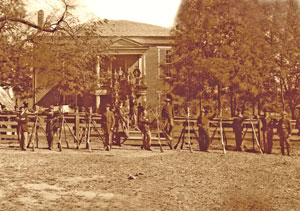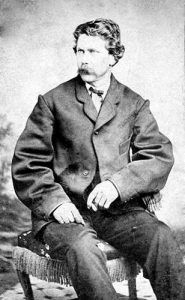Timothy H. O’Sullivan was an American photographer, best known for his photographs taken during the Civil War and in the American West.
Born in New York City in about 1840, O’Sullivan began working as an apprentice to famed Mathew Brady when just a teenager. When the Civil War began in early 1861, he joined the war effort and was commissioned a first lieutenant in the Union Army. Over the next year, he fought in Beaufort, Port Royal, and Fort Walker in South Carolina; and Fort Pulaski, Georgia.
After being honorably discharged, he joined Brady’s team in photographing the Civil War. However, he soon left Brady to photograph Civil War battlefields on his own. In July 1862, O’Sullivan followed Major General John Pope’s Northern Virginia Campaign. He soon joined up with Alexander Gardner, who had also worked for Matthew Brady, but, quit in late 1862, probably in part because of Brady’s practice of attributing his employees’ work as “Photographed by Brady.”
In July 1863, O’Sullivan created his most famous photograph, “The Harvest of Death,” depicting dead soldiers from the Battle of Gettysburg. In 1864, following General Ulysses S. Grant’s trail, he photographed the Siege of Petersburg before briefly heading to North Carolina to document the siege of Fort Fisher. That brought him to the Appomattox Court House, the site of Robert E. Lee’s surrender in April 1865. After the Civil War, Alexander Gardner published a two-volume work, Gardner’s Photographic Sketch Book of the Civil War, in 1866, which included 44 of O’Sullivan’s photographs.

Federal troops with rifles in front of the Appomattox, Virginia Court House. Timothy H. O’Sullivan, April 1865.
O’Sullivan’s experience photographing in the field earned him a position as the official photographer for the Geological Exploration of the Fortieth Parallel led by Clarence King. From 1867 to 1869, he followed the first governmental survey of the American West. The expedition began at Virginia City, Nevada, where he photographed the mines and worked eastward. His job was to photograph the West to attract settlers. O’Sullivan’s images were among the first to record the prehistoric ruins, Navajo weavers, and pueblo villages of the Southwest.
In 1870 he joined a survey team in Panama to survey for a canal across the isthmus. From 1871 to 1874 he returned to the southwestern United States to join Lieutenant George M. Wheeler’s survey west of the One-Hundredth Meridian. He faced starvation on the Colorado River when some of the expedition’s boats capsized. Few of the 300 negatives he took survived the trip back East.
He returned to Washington, D.C., in 1874 and made prints for the Army Corps of Engineers. In 1880, he was made chief photographer for the United States Treasury. However, the position would be brief as he died at Staten Island, New York on January 14, 1882, of tuberculosis at the age of 41.
Compiled by Kathy Alexander, updated June 2021.
Also See:
Artist, Photographer, & Publisher Photo Galleries

